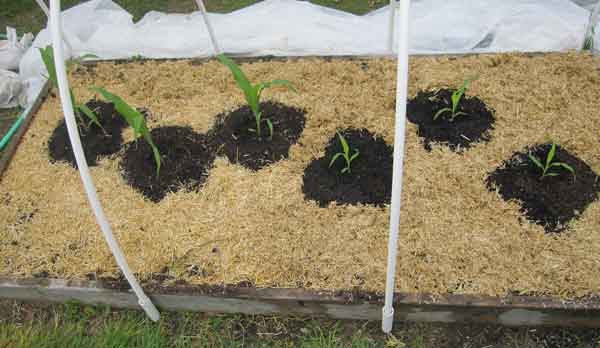Nothing says summer like a freshly picked ear of homegrown sweet corn. Growing backyard corn isn't difficult, and although corn takes up a bit of space and usually returns only two ears per plant, those ears are worth the time and effort. You can harvest corn around 70-80 days from the seeding date, depending on the weather, and corn can be grown either from seed or from transplants.
There are many types of corn (dent, popcorn, broom, etc.), but these are the types most often grown in backyard gardens:
Most books say sweet corn can only be direct seeded once the soil warms up, but this is our third year growing backyard corn and it does just fine from transplants. The corn seeds are planted in 3" cell packs and sprout very quickly. The corn seedlings grow fast so don't sow the seeds into the cell packs until the outdoor soil has warmed up to at least 60°, and if you're direct seeding the corn the soil temp is even more important. We're in the Northeast (Zone 5) so the corn seedlings benefit from being hardened off in a cold frame before being transplanted into the raised beds. Corn needs sun and warmth so choose a sunny planting location. The image below shows how quickly the corn grew in a 40 day period once the weather warmed up:

The seed pack called for spacing of 10-12", but our raised beds usually divide into 14" spacing which seems to work well. If you don't have a lot of room, try staggering the corn plants as shown in the image below. If the corn is planted too close there might not be enough air movement, and the leaves of the adjoining plants can get in the way of the pollen falling from the tassels to the silks. On the flip side, if there's too much space between corn plants, corn tillers (aka corn suckers) can be encouraged to grow, and since corn is wind-pollinated, too much spacing between the plants can adversely affect pollination, so stick with the recommended spacing on the seed pack. Although it's best to plant the corn in blocks, we've planted in both blocks and single rows and have gotten a good harvest every year. If you've never grown corn before, resist the urge to plant more than one variety especially if your garden is small, or at least plant the same variety (i.e., all (se) or all (syn)) because the corn plants can cross pollinate which might affect the sugar content of the corn.

Sweet corn is a fairly heavy feeder. Bed prep for our corn includes compost in the fall if available, and in the spring Happy Frog All Purpose fertilizer is incorporated into the soil a few weeks before seeding or transplanting the corn. A few weeks after the corn is transplanted, they get some fish emulsion and/or liquid kelp. The rest of the growing season usually includes Fox Farm's Liquid Big Bloom so as not to disturb the fairly shallow root system. Most info says to use a high nitrogen fertilizer for corn, but we've always used a balanced fertilizer and the corn seems to seems to do just fine. Your soil conditions and fertilzer needs will be different.
Knowing when to harvest sweet corn comes from experience, but it's not hard to figure out once you've done it a couple of times. The ears will feel full, the silks are mostly brown and almost dry, the outer husk shrinks back just a bit at the top of the ear, and some say the juices are milky when a kernel is pressed, but we've never had much luck using that as an indicator. When harvesting the ear, hold the stalk with one hand, then grasp the ear around the middle and gently press it towards the ground. The ear should snap off easily. Once the corn is harvested the stalks are left to dry in the raised beds and are harvested later on for Thanksgiving decorations.
Here's a video that follows the sweet corn from seedlings to harvest over a 68-day period.